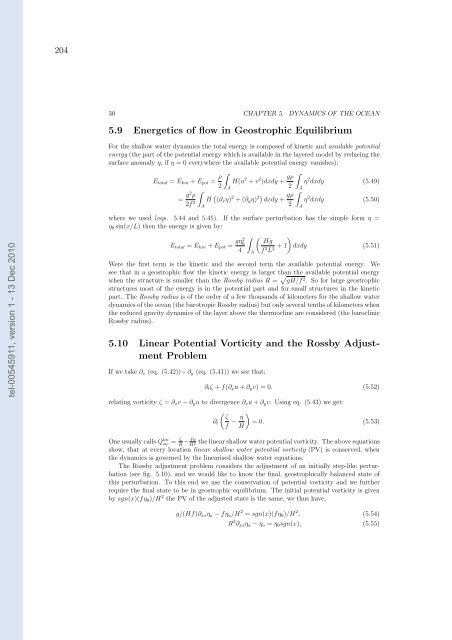Etudes et évaluation de processus océaniques par des hiérarchies ...
Etudes et évaluation de processus océaniques par des hiérarchies ...
Etudes et évaluation de processus océaniques par des hiérarchies ...
You also want an ePaper? Increase the reach of your titles
YUMPU automatically turns print PDFs into web optimized ePapers that Google loves.
204<br />
30 CHAPTER 5. DYNAMICS OF THE OCEAN<br />
5.9 Energ<strong>et</strong>ics of flow in Geostrophic Equilibrium<br />
For the shallow water dynamics the total energy is composed of kin<strong>et</strong>ic and available potential<br />
energy (the <strong>par</strong>t of the potential energy which is available in the layered mo<strong>de</strong>l by reducing the<br />
surface anomaly η, if η = 0 everywhere the available potential energy vanishes):<br />
E total = E kin + E pot = ρ ∫<br />
H(u 2 + v 2 )dxdy + gρ ∫<br />
η 2 dxdy (5.49)<br />
2 A<br />
2 A<br />
= g2 ρ<br />
H<br />
2f<br />
∫A<br />
( (∂ 2 x η) 2 + (∂ y η) 2) dxdy + gρ ∫<br />
η 2 dxdy (5.50)<br />
2 A<br />
tel-00545911, version 1 - 13 Dec 2010<br />
where we used (eqs. 5.44 and 5.45). If the surface perturbation has the simple form η =<br />
η 0 sin(x/L) then the energy is given by:<br />
E total = E kin + E pot = gη2 0<br />
4<br />
∫<br />
A<br />
( Hg<br />
f 2 L 2 + 1 )<br />
dxdy (5.51)<br />
Were the first term is the kin<strong>et</strong>ic and the second term the available potential energy. We<br />
see that in a geostrophic flow the kin<strong>et</strong>ic energy is larger than the available potential energy<br />
when the structure is smaller than the Rossby radius R = √ gH/f 2 . So for large geostrophic<br />
structures most of the energy is in the potential <strong>par</strong>t and for small structures in the kin<strong>et</strong>ic<br />
<strong>par</strong>t. The Rossby radius is of the or<strong>de</strong>r of a few thousands of kilom<strong>et</strong>ers for the shallow water<br />
dynamics of the ocean (the barotropic Rossby radius) but only several tenths of kilom<strong>et</strong>ers when<br />
the reduced gravity dynamics of the layer above the thermocline are consi<strong>de</strong>red (the baroclinic<br />
Rossby radius).<br />
5.10 Linear Potential Vorticity and the Rossby Adjustment<br />
Problem<br />
If we take ∂ x (eq. (5.42)) - ∂ y (eq. (5.41)) we see that:<br />
∂ t ζ + f(∂ x u + ∂ y v) = 0. (5.52)<br />
relating vorticity ζ = ∂ x v − ∂ y u to divergence ∂ x u + ∂ y v. Using eq. (5.43) we g<strong>et</strong>:<br />
( ζ<br />
∂ t<br />
f − η )<br />
= 0. (5.53)<br />
H<br />
One usually calls Q lin<br />
sw = ζ H − fη<br />
H 2 the linear shallow water potential vorticity. The above equations<br />
show, that at every location linear shallow water potential vorticity (PV) is conserved, when<br />
the dynamics is governed by the linearised shallow water equations.<br />
The Rossby adjustment problem consi<strong>de</strong>rs the adjustment of an initially step-like perturbation<br />
(see fig. 5.10), and we would like to know the final, geostrophically balanced state of<br />
this perturbation. To this end we use the conservation of potential vorticity and we further<br />
require the final state to be in geostrophic equilibrium. The initial potential vorticity is given<br />
by sgn(x)(fη 0 )/H 2 the PV of the adjusted state is the same, we thus have,<br />
g/(Hf)∂ xx η a − fη a /H 2 = sgn(x)(fη 0 )/H 2 , (5.54)<br />
R 2 ∂ xx η a − η a = η 0 sgn(x), (5.55)
















